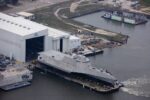Australian defense technology firm DroneShield has announced that its DroneSentry-X system has received official recognition from the United Kingdom’s National Protective Security Authority (NPSA). This certification marks a significant milestone in the deployment of counter-unmanned aerial system (C-UAS) technologies across the UK’s critical infrastructure sectors.
What is the NPSA and Why Its Rating Matters
The National Protective Security Authority (NPSA), formerly part of the Centre for the Protection of National Infrastructure (CPNI), is responsible for setting protective security standards across sensitive sectors in the UK. Its endorsement is a prerequisite for deploying certain technologies at high-risk sites such as airports, power stations, government buildings, and defense facilities.
NPSA certification indicates that a product has undergone rigorous technical evaluation and meets specific performance and reliability criteria. In the case of C-UAS systems like DroneSentry-X, this includes testing against various drone threats under realistic operational conditions. As drone incursions become more frequent and sophisticated — including incidents involving swarms or GPS spoofing — having a validated mitigation system is essential for national resilience.
Inside DroneSentry-X: Capabilities and Architecture
DroneSentry-X is an integrated multi-sensor counter-drone platform developed by DroneShield. It combines passive radio frequency (RF) detection with optional electronic countermeasures to detect, identify, track, and mitigate unauthorized drones. The system is designed to be vehicle-mounted or fixed-site deployed and supports modular upgrades.
Key features include:
- RF Detection: Wideband spectrum monitoring to detect drone control signals (e.g., 2.4 GHz/5.8 GHz ISM bands) without emitting RF energy.
- Direction Finding: Geolocation of drone controllers via triangulation using multiple sensors.
- AI/ML Classification: Machine learning algorithms trained on extensive signal libraries to classify drone types and threat levels.
- Electronic Countermeasures: Optional RF jamming modules integrated into the same chassis for targeted disruption of control or GNSS signals.
The system supports integration with third-party radars or electro-optical/infrared (EO/IR) sensors via open APIs to enable layered situational awareness.
NPSA Recognition: Scope and Implications
The recognition by NPSA applies specifically to DroneSentry-X’s passive RF-based detection capabilities. According to DroneShield’s announcement on October 25th, 2025, this qualifies it for deployment at sites governed by UK protective security policies — particularly where active jamming may not be permitted due to regulatory constraints from Ofcom or proximity to civilian infrastructure.
This certification does not automatically include approval of active mitigation components (e.g., jammers), which are subject to separate licensing under UK law. However, it significantly lowers procurement barriers for public sector entities seeking compliant early-warning solutions against drone threats.
C-UAS Demand Rising Across Critical Infrastructure
The NPSA certification comes amid growing demand in the UK and globally for scalable C-UAS solutions as commercial drones proliferate. High-profile incidents — such as the December 2018 Gatwick Airport shutdown caused by suspected drone sightings — have underscored vulnerabilities in airspace security near sensitive locations.
The UK’s Home Office has prioritized investment in counter-drone capabilities through its Counter-Unmanned Aircraft Strategy published in 2019 and updated guidance from the Civil Aviation Authority (CAA). The strategy emphasizes layered defense architectures combining detection with proportionate response mechanisms tailored to each site’s risk profile.
With threats ranging from hobbyist overflights to criminal smuggling operations and potential state-sponsored reconnaissance missions using small UAVs, certified systems like DroneSentry-X provide a vetted option within these frameworks.
Commercial Outlook and Competitive Landscape
The NPSA recognition enhances DroneShield’s market position within the competitive European C-UAS sector. Other vendors with similar certifications include Dedrone (Germany/US), CerbAir (France), and OpenWorks Engineering (UK), each offering variations on RF detection or kinetic interception technologies such as net guns or interceptor drones.
DroneShield CEO Oleg Vornik stated that this milestone “opens up new procurement pathways” within both government contracts and private-sector clients operating under critical national infrastructure designations. The company has previously secured contracts with NATO members and Five Eyes partners including Australia’s Department of Defence and US federal agencies via GSA schedules.
Tactical Use Cases Beyond Fixed Sites
While much focus is on static critical infrastructure protection, DroneSentry-X also supports mobile deployments — including convoy protection or rapid perimeter establishment during temporary events such as summits or military exercises. Its low-SWaP profile allows integration onto tactical vehicles without requiring external power sources or heavy mounting hardware.
This flexibility aligns with emerging doctrines around agile force protection against low-cost aerial threats in hybrid warfare environments — especially given increasing use of FPV drones in Ukraine-Russia conflict zones where traditional IADS are ineffective at very low altitudes (<200 m).
A Step Toward Broader Interoperability?
NPSA certification may also pave the way toward greater interoperability between allied nations’ C-UAS frameworks under NATO STANAGs or bilateral agreements like AUKUS. While standardization remains fragmented across jurisdictions due to differing spectrum laws and threat assessments, common validation schemes could help harmonize procurement across borders — especially among Five Eyes members facing similar threat vectors from commercial off-the-shelf drones repurposed for ISR or kinetic roles.
Conclusion: A Strategic Win Amid Regulatory Complexity
The formal recognition of DroneSentry-X by the UK’s lead protective security authority represents more than a marketing credential — it reflects technical maturity validated through stringent evaluation processes. As regulatory environments remain cautious about active jamming solutions due to collateral risks, passive RF detection systems offer an immediate compliance-ready path forward in many operational contexts.
This milestone strengthens DroneShield’s credibility not only within Britain but also across markets where government buyers seek pre-vetted solutions aligned with Western security standards. With drone threats evolving faster than legislation can adapt, having certified tools already on-hand offers a decisive edge in safeguarding airspace integrity around critical assets.










